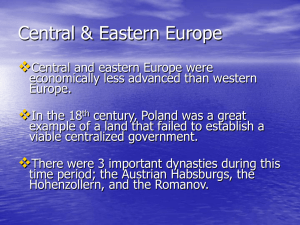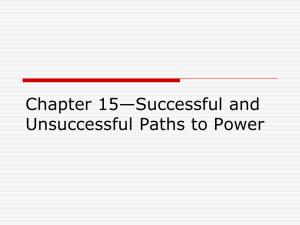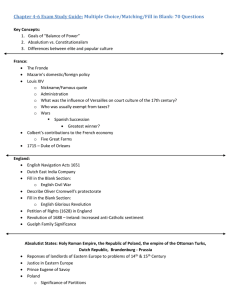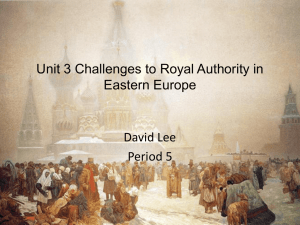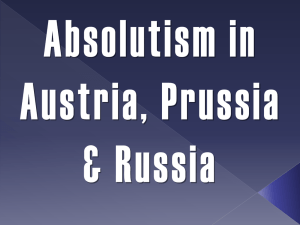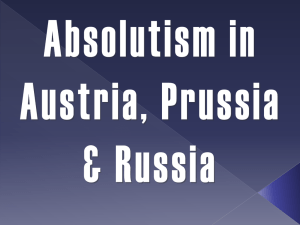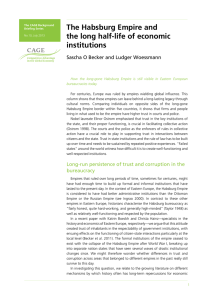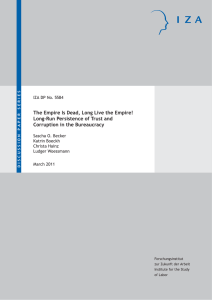Lecture_3_Spring_2014
advertisement
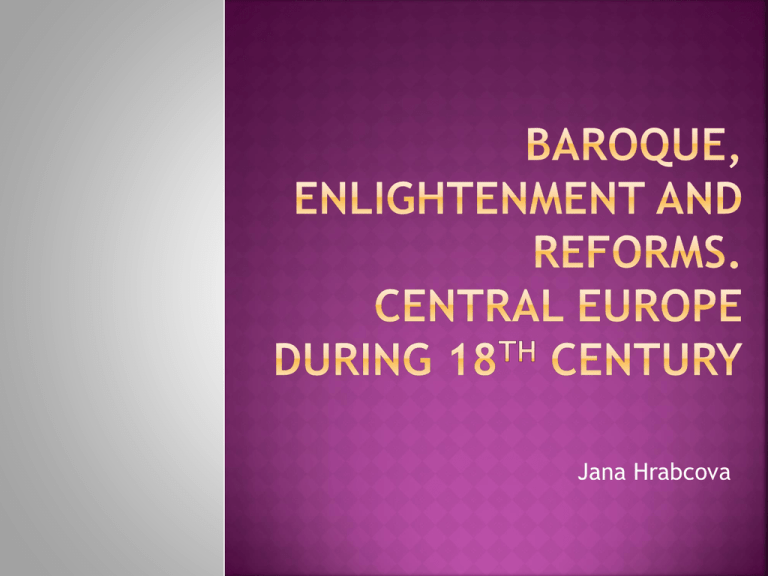
Jana Hrabcova Around 1600 in Italy, in the Central Europe during 17th and 18th century The last universal artifical style in Europe Encouraged and supported by the Catholic Church – in response to the Protestant Movement the arts should communicate religious themes in direct and emotional involvement Paintings – Karel Škréta, Václav Vavřinec Reiner Sculptures – Matyas Bernard Braun (Charles Bridge – sculptures, Kuks), Ferdinad Maxmilian Brokoff (Charles Bridge) Music – Johann Sebastian Bach, Georg Friedrich Händel Czech composers:Adam Václav Michna z Otradovic, Jan Dismas Zelenka Literature Architecture Karel Škréta – Self Portrait Karel Škréta - Paris and Helen Pilgrimage Church of St John of Nepomuk on Zelena hora Hill -Jan Blažej Santini-Aichel http://www.santini.cz/index-en.aspx Prague – St. Nicholas Church – Christof and Kilian Ignac Dienzenhofer Kuks – Matyas Bernard Braun Charles Bridge – St. Adalbert – F. M. Brokoff Chateau Vranov nad Dyjí – Jan Bernard Fischer von Erlach http://www.zamekvranov.cz/en/ Chateau Milotice - Josef Emanuel Fischer von Erlach http://www.zamekmilotice.cz/ virtualni-prohlidka-2/ Green Market - The Parnas Fountain - Johann Bernhard Fischer von Erlach St. Johns´Church, Minoritská street, Brno St. Thomas’ Church – Moravské Square The Plague Column Square Svobody The wars with Ottoman Empire – ruling over the whole Balkan Peninsula and a part of Hungary 1683 – Vienna besieged by the Ottomans Polish king Jan (John) III Sobieski (1674–1696) helped Vienna and the Ottomans were defeated 1697 – The Ottomans were defeated at the Battle of Zenta 1699 - Peace Treaty of Karlowitz (Sremski Karlovci) – Hungary,Croatia and Slavonia incorporated into the Habsburg Monarchy again 1701–1714 – the Wars of Spanish Succession – Habsburgs x Bourbons (French ruling dynasty) Bourbons won and got Spanish throne Habsburgs got territories in Italy (Naples, Sardinia, Milan) and Spanish Netherlands as compensation Habsburg Monarchy became a great power at the beginning of 18th century and a leading power in Central Europe Joseph I (1705–1711) Charles VI (1711–1740) a dynastic crisis - no living male heirs 1713 –Pragmatic Sanction a law which ensured the succession by female family members if there were no male heirs ensuring the indivisibility of the Habsburg Empire (Austrian Lands, the Lands of Bohemian Crown and Hungary) - the Habsburg ruler ruled as a hereditary sovereign Recognized by most European governments as an iternationally valid document the re-Catholization pressure increased 1737–1739 – war with Ottoman Empire born in 1717 Her husband was Francis Stephen of Lorraine (Holy Roman Emperor since 1745) They had 16 children, 13 of them survived her right to rule was based on the Pragmatic Sanction from 1713, but after Charles´ death some rulers challenged its validity and presented their claims to Habsburg lands the War of Austrian Succession in 1740– 1748 she managed to defend almost her entire heritage but it was clear that it is necessary to put a big effort into perfecting the army and reforms of the state Seven Years´ War (1756–1763) - Frederick II invaded Bohemia but in the end the Prussians were pushed from Bohemia since the mid-1760s Maria Theresa could finally focus on the consolidation and modernization of her lands – enlightened reforms formation of new administration and the new institutions and beraucratic machinery she decided to transform the complex multinational domonion into a compact state which was to be a state unified on legal, ideological and later also linguistic levels (germanisation) it was to be politically and economically strong state, managed centrally and efficiently by qualified people (important – education, experiences and personal abilities, not the social status) the administration was centralised (this concerned only Austria and Bohemia, not Hungary, which obtained many privileges for its help in the War od Austrian Succession, this ensured different development) Hygiene and medical services reforms better health care hospitals vaccination – but distrust urban sanitation measures→ population increase education system reforms (obligatory school attendance for children from 6 to 12 years old) schools under the state control, unified curriculum universities also under the state control, new study programmes – economics, technical sciences legal reforms - equality before the law was declared, humanization of punishments, torture dissapeared from court procedures, capital punishment was temporarily abolished in 1780s 1769 – Maria Theresa´s Penal Code 1786 – General Civil Code 1787 – Joseph II´s Penal Code tax reform - land register and tax and urbarial reforms, universal land tax, which was to be paid by all the population (earlier the aristocracy and the church had been exempted from the taxes) uniformed units of size and weight, unification of currency, extensive road network, abolished customs barriers between the provincies – the trade became much easier in the Czech lands since mid- 18th century, the peak during Joseph II´s reign, sometimes also called josephinism centres of enligtened life – noble salons and Masonic lodges – enlightened state clerks and army officers focused on charity 1784 – the Bohemian Society of Sciences – focused on natural and historical sciences the Bohemian enlightment and science was linguistically mostly German The eldest son of Maria Theresa and Francis Stephen of Lorraine, born in 1741 Well educated, diligent popular ruler often traveled incognito (Duke of Falkenstein) – tried to meet people and listen to their opinions Patron of the arts Holy Roman Emperor since 1764 1760 – married Princess Isabella of Parma (died in 1762), second wife – Maria Josepha od Bavaria None of his children survived censorhip was loosened, not completely freedom of speech, but citizens could comment on domestic political matters He tried to reform highly conservative Catholic church the church was put under state control, its property was taxed education of the priests was controlled by the state the priest were in charge of educational and administrative activities – administered population registires, executed medical supervision etc. Joseph II dissolved those monasteries which were not engaged in activities beneficial to either state or citizens – education, healthcare or charity (so those which were begging were cancelled) 1781 – Joseph II´s Toleration Patent – granted freedom of religion to non-Catholic denominations: Orthodox, Calvinist and Lutheran the era of state promoted re-Catholization was definitely over later in 1780s the rights were also applied to the Jews, who also became the equal citizens 1781 – Serfdom Patent (abolished restricions and granted the peasants personal freedom, they became equal citizens) 1785–1789 – Josephine land register was elaborated, the taxation was based on real economic conditions – quality of the soil, types of plantation, other necessary expenses the Enlightened state reforms, particularly the changes intorduced by Emperor Joseph II, did not meet with a universaly possitive response especially the nobility refused to accept the loss of its political possition, privileges and power over the peasants, but many people had problem with state control of the church and of the life in general, they did not like interventions into folk customs and religious traditions Some of his reforms were cancelled after his death – his brother Loepold II (1790–1792) who succeeded him was under the heavy pressure of the nobility and the church Maria Theresa (1717 – 1780) Joseph II (1741 – 1790) in the second half of the 17th century – unstable region with several antiHabsburg rebellions taking place 1699 – Peace Treaty of Karlowitz (Sremski Karlovci) with Otoman Empire – most of Hungarian areas liberated from Otomans Personal union with Austria Many nationalities – Hungarians only 40 % of inhabitants (Slovaks, Croats, Serbs, Romanians etc.) after Thirty Years´ War the European power structure was rearranged The Holy Roman Empire was fragmented into many territories (360 states) - de facto they were sovereign and had their own rulers - this limited the power of the Holy Roman,the power of the Emperor was very weak, the Empire Diet did not work in fact the Holy Roman Empire had no army, no central autority after the Thirty Years´ War the Kingdom of Prussia in the North- Eastern part of the Holy Roman Empire started to grow and politicaly strenghten, the rulers were coming from the House of Hohenzollern Prince Elector Frederick William (1640–1688) – ecomonical reforms, strong power of the ruler his son Frederick III (1688–1713) - he was crowned the King as Frederick I the capical city was Berlin – rebuilt, administrative and cultural centre of the state Frederick William I (1713–1740) – called the Soldier King, thrifty, practical, good ruler creator of the Prussian bureaucracy and the professionalized standing army, which he developed into the best army in Europe Frederick II (1740 – 1786) – the Great, the King of Prussia he was succesful reformer practised enlightened absolutism he introduced a general civil code, abolished torture he also promoted an advanced secondary education supported science and arts – according to the French example he built the Chateau Sanssouci he used the power of his army to conquer Silesia, which was the richest province of Habsburg Monarchy In 1740, Prussian troops crossed over the undefended border of Silesia and the so called Silesian Wars began (1740–1763) these wars have been groped with the War of Austrian Succession (1740–1748) the third largest state in Europe till 1770s, Polish-Lithuanian Commonwealth – it was very difficult to govern such a large country many nations and many confessions living in Poland a great influence of Russia in 18th century – the Russian tsars installed Polish kings in fact – firstly the Saxony dynasty and later the Russian Empress Catherine the Great installed the last Commonwealth King Stanisław August Poniatowski (1764–1795) the general decline of Poland was used by its neighbouring states – Prussia, Russia and Habsburg Monarchy and resulted in the Partition of Poland in the second half of the 18th century 1st partition – 1772 Poland lost 1/3 of land and 1/3 of inhabitants the reform magnates wanted to save Poland by introducing some reforms and the constitution the Polish Constitution was the first written constitution in Europe but the pro-Russian conservative Polish magnates, the Confederation of Targowica, fought against Polish forces supporting the constitution which were defeated 2nd partition – 1793 Prussia named its newly gained province South Prussia the last attempt to save at least the rest of Poland was the Kościuszko Uprising in 1794 – the leader Tadeusz Kościuszko the uprising was organized by nobility and burghers, the peasants did not allied the Russians allied with Prussia and the uprising was totaly defeated 3rd partition – 1795 – the rest of Poland divided between Russia and Prussia Results of the Partition of Poland: To Russia: Latvia, Lithuania, Belarus, great part of the Ukraine To Habsburg Monarchy: Lesser Poland, the Kingdom of Galicia, city of Cracow, City of Lwow To Prussia: Greater Poland with the City of Poznan, Mazuria with Warsaw TAPIÉ, Victor Lucien. The rise and fall of the Habsburg monarchy. London: Pall Mall Press, 1971. HUBATSCH, Walther. Frederick the great of Prussia: absolutism and administration. London: Thames and Hudson, 1975. MAC DONOGH, Giles. Frederick the Great: A Life in Deed and Letters. New York: St. Martin's Griffin, 2001.
